Return to my Checkers pages
Go to my home page
Loy's Checkers Problems
Copyright 1997 etc., Jim Loy
You may print this and show it to
others. But, this article will eventually be part of a book that I am writing.
So, please do not distribute it widely.
If you need help reading checkers notation, please print out the
numbered board.
Also see Easy Checker Problems and
Jim's Endings. Here are some checkers problems which
have come up in my work on various openings, and mail games. Many are not pure
problems, as there are often pieces that are relatively unnecessary in the
solutions. The solutions are at the end of this article.
|
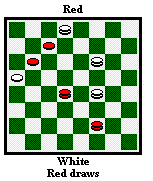
Problem #1:
This position could have come up in one of my mail games.
|
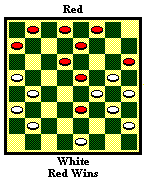
Problem #2:
This may be very difficult. |
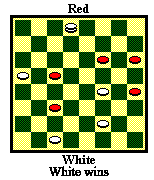
Problem #3:
This position could have come up in one of my mail games.
|
|
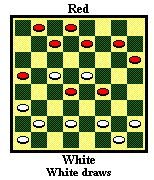
Problem #4:
Conrad Cantor left this as a Red win, in his book The Kentucky
Glasgow (page 16, the end of note A, where the last move is a mistake).
Find the shot to draw. |

Problem #5:
This position came up in a practice game from one of the barred
openings (9-13 21-17 10-14). |

Problem #6:
Here is a position that is reminiscent of Fifth Position. It came up while I was proof reading the
1999 I-D booklet. |
|
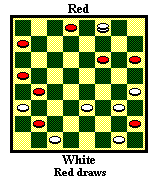
Problem #7:
This is my correction of F.Wolf-F.Hobart. |

Problem #8:
This is my correction of W. R. Barker - J.
Wyllie, 1874 World Championship Match, game #21 |

Problem #9:
This position is a correction to Courtney's Souter, Chapter
1, var. 25. |
|

Problem #10:
This came up while I was studying one of my email games. |

Problem #11:
A very pleasant idea. |

Problem #12:
This is the end of Walcott-Lowder in the recent GAYP National
Tournament. |
|

Problem #13:
This one may seem difficult, at first. |

Problem #14:
This may be a little difficult. But it is rewarding. |

Problem #15:
This position is a correction to Courtney's Souter,
Chapter 1, var. 83. |
|

Problem #16:
I was studying an opening. |

Problem #17:
This is a position in Churchill's Compilations. |

Problem #18:
This is a position in Churchill's Compilations. |
|
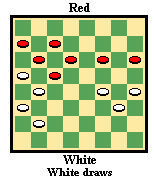
Problem #19:
This position could have come up in Courtney's Souter,
Chapter 1, var. 97. |

Problem #20:
This position is from Churchill's Compilations. |
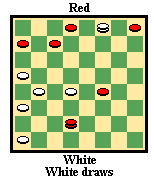
Problem #21:
White draws. This is from my study of an opening. |
|

Problem #22:
I was studying an opening. |
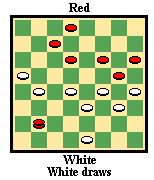
Problem #23:
This is from M. Tinsley - N. W. Banks, 1952 match, game
#34. |

Problem #24:
This position is called a WW in Hester's Defiance.
|
|
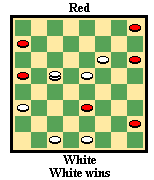
Problem #25:
This was the final position of a drawn mail game. |
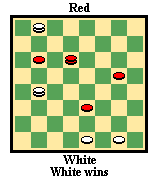
Problem #26:
This from a game in Churchill's Compilations. |
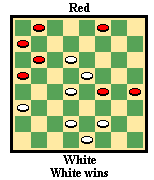
Problem #27:
I was studying an opening. |
|
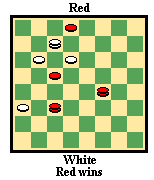
Problem #28:
This could have come up in Ruos-Davis, 1922 American
Tournament. |
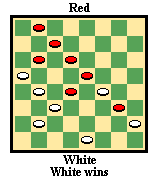
Problem #29:
This may not be very difficult. |

Problem #30:
I was studying a published game. |
|
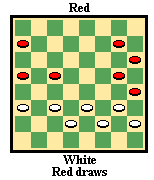
Problem #31:
This is from the Childers-Fortman 1994 WCM booklet. |
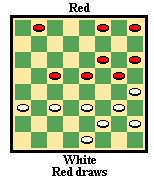
Problem #32:
This is from my study of an opening. |

Problem #33:
This is from R. M. Dionisio - R. L. Fortman, 2001 ItsYourTurn.com,
March fast tournament. |
|
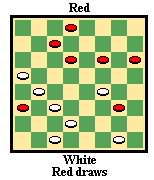
Problem #34:
This is from my study of an opening. |
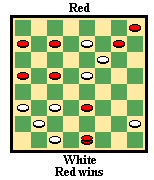
Problem #35:
This is from my study of an opening. |
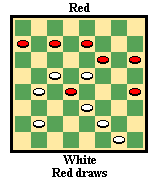
Problem #36:
This was given as a WW by Jack Mourning in Churchill's
Compilations |
|
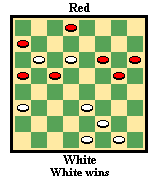
Problem #37:
Overlooked by A. J. Heffner. |

Problem #38:
A position in Churchill's. |

Problem #39:
A position from the Switcher. |
|

Problem #40:
From one of my quizzes. |
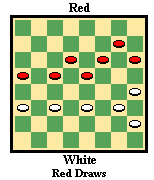
Problem #41:
The end of Jim Loy - Clint Olsen, ItsYourTurn.com 2003. |
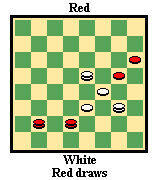
Problem #42:
This is a position from R. Pike's 101 Checker Puzzles. |
|
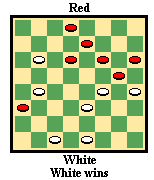
Problem #43:
This is a position from analysis by V. Oquendo on
ItsYourTurn.com. |
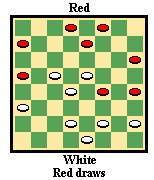
Problem #44:
This is the final position of Wold-Sheehan, 2002 I-D, which was an
agreed draw. |
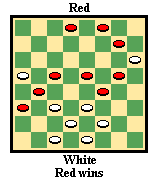
Problem #45:
A position by E. Frazier. |
|
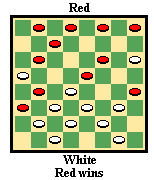
Problem #46:
This is a position from Churchill's Compilations. |

Problem #47:
This could have come up in one of my mail games. |

Problem #48:
A correction to published play. |
|
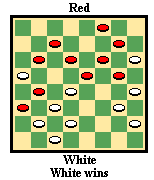
Problem #49:
A position from Basic Checkers. |

Problem #50:
A position from Elam's Checker Board. |

Problem #51:
Similar to a position in Elam's Checker Board. |
|

Problem #52:
A position from Ryan's Tricks Traps and Shots, p. 50, note
C. |
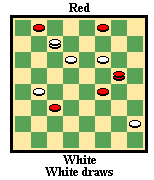
Problem #53:
This is an ending by L. L. Hall, who gave this position as a
RW. |
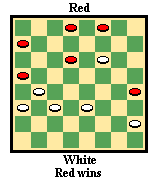
Problem #54:
From Atkinson's White and Coloured Doctors, p.42,
v.19. |
|
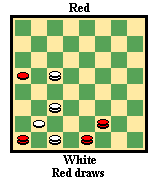
Problem #55:
From Atkinson's White and Coloured Doctors, p.28,
v.14. |
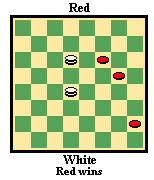
Problem #56:
Ron Day wrote to me and suggested 14-18 to bring about the above
position from Ryan's Scientific Checkers Made Easy, problem
#15. |
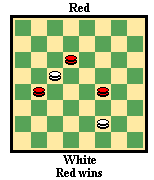
Problem #57:
Red wins. |
|
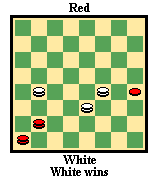
Problem #58:
A position won by A. Jordan. |

Problem #59:
This position is from Inside Checkers by Walter W.
Walker. |

Problem #60:
This could have come up in one of my games. |
|
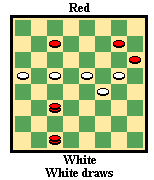
Problem #61:
This is from my study of an opening. |

Problem #62:
A position by L. L. Hall. |

Problem #63:
I was studying an opening. |
|
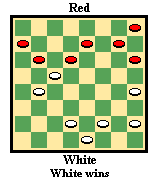
Problem #64:
Lees' Guide, p.64f. |

Problem #65:
Lees' Guide, supplement, p.259. |

Problem #66:
Lees' Guide, p.113v. |
|
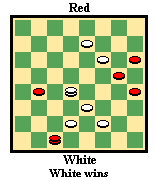
Problem #67:
By J. Kear Jr., in Lees' Guide, appendix, p.234. |

Problem #68:
A. Bjerkness, Lees' Guide, appendix, p.235. |
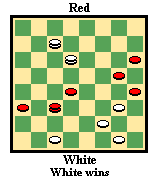
Problem #69:
J. Macfarlane, Lees' Guide, p.128y. |
|
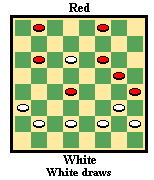
Problem #70:
From my study of an opening. |
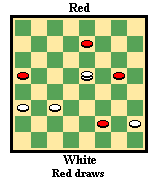
Problem #71:
W. Adams - G. Leclair, 1952 U.S. Nat., p.47 |
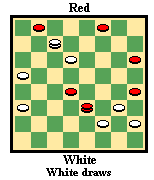
Problem #72:
E. McConnell - H. Axford, 1983 Lakeside, White resigned here, in a
drawn position. |
|
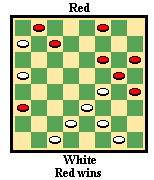
Problem #73:
A position by M. Long in the 1990 I-D booklet. |

Problem #74:
From the 2003 I-D booklet, p.5, v.1, an ineffectual triple
fork. |
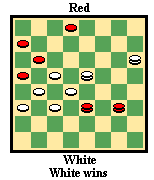
Problem #75:
From the 2003 I-D booklet, p.5, note A. |
|
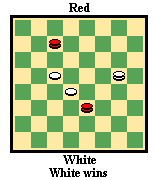
Problem #76:
E. Fuller - L. Munger, 1973 Florida Open, final position. |
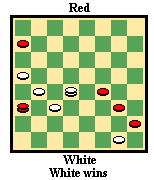
Problem #77:
E. Lowder - E. Rolader, 1972 Florida Open, final
position. |

Problem #78:
E. Lowder - E. Gill, 1970 US National, g.96. |
|
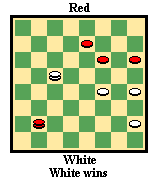
Problem #79:
H. L. Owen - L. Balderson, 1972 U.S. National, g.6. |
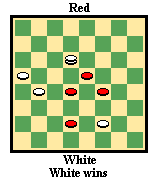
Problem #80:
C. Jackson - W. Haddock, 4th International Mail Match. |
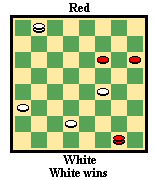
Problem #81:
L. Balderson - R. Fortman, 1984 Florida Open. |
|

Problem #82:
V. Monteiro - E. Lowder, 1980 U.S. National, g.29, v.1. |
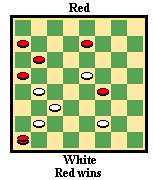
Problem #83:
K. Albrecht - E. Lowder, 1960 Lakeside, p.5. |
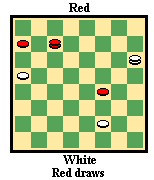
Problem #84:
M. Holley - T. Laverty, 1980 Southern Open. |
|

Problem #85:
R. Butler - L. Taylor, 1976 Southern Open, final
position. |
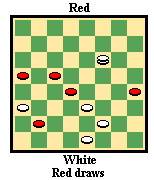
Problem #86:
V. Tarter - Priest, 1973 Southern Open, final position. |

Problem #87:
C. Crawford - E. Morrison, 1979 Florida Open, final
position |
Solutions:
Solution #1: Red has a nice shot, 9-14! 2-9 18-23! 19-26 (9-18
23-7 draw) 27-31 9-18 31-8 draw.
Comments: The diagrammed position arises when White moves 16-19. Since
the shot is an easy draw, White should instead move 16-20, which is a draw if
Red is careful: 27-23 (I think 27-32 loses) 20-24 18-22 2-7 23-18 draw.
Actually the ending can go on forever, with White trying to outmaneuver Red.
But, it should be a draw. A very similar draw occurs in Kear's
Encyclopedia, p.192F.
Solution #2: 23-26! (B. Titus, quoted in E. Churchill's
Compilations, gave 23-27 to draw, and 15-18? to lose) 31-22 2-6! RW.
White must give back the two pieces, and more.
Comments: This position is from the White Doctor opening: 10-14 22-18
12-16 24-20 16-19* 23-16 14-23 26-19 8-12* 25-22 6-10* 29-25 11-15 22-17 (or
others) 15-24 28-19 4-8 32-28 (or others) 8-11 17-13 9-14 30-26 14-18* 26-22
11-15 27-24 18-23* 22-17? (B. Titus gave 16-11 to draw) [diagram]. This
position was considered a draw, until I found the winning move for Red. Such a
correction to published play is known as a "cook." Think about the position,
before you look at the solution.
Solution #3: 2-7 11-16 27-24! 20-27 7-10 16-23 10-19 WW.
Solution #4: 15-10! (or 27-23 18-27 32-16 12-19 and 15-10 or
26-23 to same) 6-15 27-23 18-27 32-16 12-19 26-23 19-26 21-17 13-22 25-4 and a
fairly easy draw. By the way, Red is lost if he doesn't go for the shot.
Solution #5: Red has a nice draw with: 15-18! (1-5 17-14 2-7 9-6
5-9 WW?) 24-15 18-22 26-23 22-26 23-18 (23-19 1-5 draw?) 26-30 17-13 30-26
15-11 26-22 18-15 22-18 9-6 2-9 13-6 3-7! 11-2 18-11 32-27 28-32 draw.
Solution #6: The solution is simple for computers, but very
difficult for humans. To win, you have to walk into a trap: 12-16!! (forcing
White to win the piece. If 3-8 23-19 is a draw shown by Jerry Childers) 24-19
15-24 28-12 10-15, and White must give away three pieces.
Solution #7: 2-6! (others probably lose) 21-14 6-9 30-21 9-27
32-23 11-15 draw.
Solution #8: 25-22 18-25 29-22 1-5 (wins a piece) 16-12 8-11 12-8
14-17 21-14 9-25 8-3 7-10 27-24 draw. White regains the piece.
Solution #9: 31-26! 15-24 6-15 28-32 15-10 WW.
Solution #10: 2-7!! 11-9 5-14 21-17 (the only thing to try) 14-21
22-18 27-31 26-22 (26-23 loses faster) 19-23 18-15 31-26 22-18 26-22 28-24
23-27 24-20 27-31 20-16 31-27 and Red wins a piece.
Solution #11: 20-16!! (not 17-22?) 19-12 17-22 draw.
Solution #12: 18-14 (Lowder carelessly moved 19-15 to lose) 22-18
(White will play the same regardless) 14-10 7-14 16-7 3-10 19-16 12-19 27-24
draw.
Solution #13: 12-8! 3-12 23-19 7-11 22-18! 13-22 (or 14-23 to
same) 4-8 draw.
Solution #14: Is this short sequence hard to see? 28-24! 19-28
22-18 WW. This came up in the analysis for the 2000 I-D booklet.
Solution #15: 6-2! (Coltherd played 23-19? to draw) 10-15 26-22
12-16 18-14 3-12 14-10 WW.
Solution #16: 10-14* 30-25 3-8 (3-7 draws, but does not threaten
to win) 25-21 6-10 20-16* (22-17 9-13 18-9 13-31 wins another piece, RW) 11-20
18-15 draw.
Solution #17: 7-11! (Churchill gives 1-5 to draw) 18-9 11-15
20-16 (otherwise White will never king) 15-24 16-11 1-5 WW (wins the
piece).
The opening: 11-15 23-18 8-11 27-23 4-8 23-19 10-14 19-10 14-23 26-19
7-14 24-20 6-10 31-27 11-15 27-23 15-24 28-19 8-11 22-18 9-13 18-9 5-14 25-22
11-15 32-28 15-24 28-19 3-7 22-18? (Churchill gives this a *. 30-26 draws)
[diagram].
Solution #18: 21-17! 18-25 26-23 13-22 23-18 15-19 16-11 regains
the piece for a draw.
The opening: 11-15 23-18 12-16 18-11 8-15 24-20 9-14 20-11 7-16 22-18
15-22 25-9 5-14 28-24 4-8 24-19 16-23 27-9 6-13 29-25 8-11 25-22 2-6 26-23 6-9
30-26 3-8 32-28 8-12 (Churchill gives this a *, but 11-15 draws as well) 22-18
(or 28-24 first) 1-5 28-24 9-14 18-9 5-14 26-22 11-15* 31-26 (Churchill gives
24-19 a * to draw) 12-16 24-20 16-19 23-16 14-18 [diagram]. Here J. E.
Nelson lost with 16-11 to G. Webb in the 1977 Dist. 9 tournament.
Solution #19: 20-16 (should be the obvious try) 11-27 19-15 10-19
17-1 9-14 1-6 14-18 6-10 draw. White regains the piece.
Solution #20: 6-9! (see the following game) 17-13 (26-22 15-18
RW) 15-19 13-6 19-26 31-22 2-9 RW (Red wins a piece).
Comments: The diagrammed position comes from K. Todd - R. Nealey, shown
in Churchill's Compilations: 12-16 24-20 8-12 28-24 3-8 24-19 11-15
20-11 15-24 27-20 7-16 20-11 8-15 22-18 15-22 25-18 4-8 29-25 8-11 25-22 12-16
23-19 16-23 26-19 9-14 18-9 5-14 30-26 6-9 22-17 (26-23 draw, A. Long - A.
Jordan, Kear's Encyclopedia, p.58, v. 17) 9-13 32-27 13-22 26-17 1-6
27-23? (27-24 draws) 11-15 19-16 [diagram] 14-18? (6-9 is my win above)
23-7 2-20 17-14 draw.
Solution #21: 29-25!! (3-7? 2-11 18-14 6-9!! 13-6 26-22 17-13
22-17 14-10 17-14 10-7 14-10 RW) 19-23 (26-22 18-14 draw) 3-7! 2-11 18-14 and
14-9 draw.
Solution #22: 12-16! 18-11 10-15 RW.
Solution #23: 31-26! (Banks moved 18-14? 25-21 to lose; see
below) 25-22 18-14 22-31 14-7 31-27 7-3 27-18 3-8 16-23 8-22 draw.
The game: 10-14 22-17 7-10 17-13 3-7 25-22 14-17 21-14 9-25 29-22 11-15
23-18 5-9 18-11 8-15 27-23 9-14 24-19 15-24 28-19 4-8 22-18 (called a mistake
by Wiswell. 31-26 or 30-25 are PP draws) 17-22 32-27 (18-15 draws, Banks in the
match book) 8-11 27-24 11-16 24-20 7-11 30-26 22-25 26-22 25-30 22-17 30-25
[diagram] 18-14? 25-21 14-7 21-14 7-3 14-10 3-8 11-15 20-11 15-24 8-3
24-28 11-8 28-32 8-4 32-28 4-8 10-15 8-4 28-24 3-8 15-10 8-11 24-20 31-27 10-14
4-8 14-10 8-3 6-9 13-6 2-9 23-19 9-13 27-23 10-14 3-8 13-17 11-15 17-21 15-18
14-17 8-11 21-25 19-15 17-22 23-19 20-24 19-16 12-19 11-16 24-20 16-23 20-16
RW, Tinsley-Banks 1952 match, game #34.
Solution #24: 6-10* 15-6 7-10 draw (continue 16-11 8-15 25-30 2-7
30-25 7-11 15-18 31-27 25-22 11-15 12-16 15-6 22-26 draw).
Comments: 11-15 23-19 9-14 27-23 8-11 22-18 15-22 25-9 5-14 29-25 6-9
25-22 9-13 24-20 11-15 32-27 15-24 28-19 4-8 22-18 14-17 21-14 10-17 19-15 7-10
(seems to draw) 15-6 1-10 23-19 17-22 26-17 13-22 18-15 (18-14 typo in Hester's
Defiance) 2-6* 27-24 3-7 20-16 10-14 30-26 22-25 26-23 [diagram]
"WW, MacFarlane" in Hester's Defiance and Churchill's
Compilations.
Solution #25: 31-26 23-27 11-8 WW. I imagine that it takes some
thought to see that this is a WW.
The game: 10-14 23-19 6-10 19-15 10-19 24-15 11-18 22-15 7-11 26-22
11-18 22-15 14-17 21-14 9-18 25-21 5-9 29-25 12-16 28-24 16-19 24-20 2-6? (9-13
draw PP) 20-16 9-14 16-11 1-5 27-23 18-27 32-16 8-12 25-22 12-19 22-17 14-18
17-14 6-9 14-10 19-24 10-6 9-13 6-2 18-27 2-6 3-8 6-10 8-12 10-14 24-28
[diagram] draw, Hudson-Caldwell, Badger Ladder 1972.
Solution #26: 17-22! 23-26 22-25 26-30 1-5 WW.
The game: 10-15 22-17 15-19 (Skull Cracker) 24-15 11-18 23-14 9-18 26-23
6-9 23-14 9-18 30-26 5-9 17-14 9-13 26-23 1-5 28-24 8-11 24-19 11-16 25-22
18-25 29-22 16-20 22-18 13-17 14-9 5-14 18-9 17-22 9-5 22-25 5-1 25-30 1-5
30-25 23-18 25-22 18-14 22-17? (other moves draw) 14-10 (32-28 draws,
Nesbitt-Ottey, 1970 National) 7-14 5-9 17-13 9-18 13-9 21-17 4-8 17-14 9-6
18-22 3-7 (2-7 also loses?) 22-26? (27-23 may win?) 8-11 26-22 6-10 22-17 10-6
17-13 6-1 14-9 20-24? (1-6 14-9 6-1 13-17 7-10 17-22 2-6 32-28 10-15 draw)
27-20 11-16 20-11 7-23 13-17 1-6 9-5 6-10 5-1 2-6 17-13 12-16 13-17 6-9
[diagram] 1-5? (17-22! 23-26 22-25 26-30 1-5 WW) 9-13 17-22 (17-21 seems
to draw) 23-26 31-27 26-30 5-9 16-19 9-5 10-7 5-1 7-11? (7-10 draws) 1-6 11-16
6-10 16-11. Here C. M. Taylor-J. M. Wheeler (in Al Flower's Checkers
Players' Delight 1976) was adjudicated a draw. But Churchill pointed out
32-28 11-15 10-7 WW.
Solution #27: 18-14! 9-18 10-7 3-10 15-6 1-10 26-23 (27-23?
draws) 19-26 31-6 5-9 6-2 9-14 27-23! 20-24 2-6 WW.
Solution #28: 14-17! 21-14 19-15 10-7 2-11 9-5 (or 14-10 to next
parentheses) 22-17 14-9 (14-10 17-14 10-7 14-10 RW) 17-14 6-1 15-10 9-6 14-9
6-2 11-16 (or 11-15) RW.
Solution #29: 17-14 10-26 19-10 6-15 (you should probably have
seen this far) 13-6 (28-10? draws) 1-10 28-19 15-24 31-6 WW.
Solution #30: 14-18 23-14 10-17 21-14 8-11 3-19 16-30 22-18 30-25
14-10 25-22 18-14 22-18 14-9 18-14 RW.
The game: 11-16 21-17 7-11 17-13 3-7 24-19 11-15 28-24 8-11 22-18 15-22
25-18 16-20 29-25 9-14 18-9 5-14 32-28 11-16 19-15 10-19 24-15 4-8 13-9 6-13
15-10 7-11 10-7 11-15 7-3 1-6 26-22? (27-24 draws?) 6-10 25-21 2-7! (R. Nealey
- Horton, 1967 I-D played 15-19 which draws, but Red won later) 30-26
[diagram]
Solution #31: 5-9! (Childers gave 8-11 to lose) 22-18 (or 24-19
14-18 22-15 9-14 is similar) 16-19 24-15 12-16 and 16-19 next. Draw.
Comments: The position arises like this: 9-13 23-18 11-16 18-14 10-17
21-14 6-9 22-18 (or 26-23 next problem) 1-6 27-23 8-11 32-27 16-20 25-21 11-15
(or 11-16) 18-11 9-18 23-14 7-16 29-25 3-7 26-23 4-8 30-26 6-9 26-22 (or 23-18)
9-18 22-15 (or 23-14) 7-10 (called a WW in the booklet) 15-6 2-9 25-22 9-14
31-26 is the diagram.
Solution #32: 15-18*!! 22-8 4-11 31-26 3-7 26-22 7-10 22-17 1-6
24-19 11-15 draw. See gst_dammer - R. L. Fortman, 2001
ItsYourTurn.com, note A, last parentheses.
Solution #33: 18-14!! (Fortman moved 27-24 to lose) 23-32 11-15
20-24 15-11 16-20 11-16 draw.
The game: 11-16 22-17 16-20 17-14 9-18 23-14 10-17 21-14 8-11 25-22 6-10
29-25 10-17 22-13 11-15 24-19 15-24 28-19 4-8 25-22 8-11 22-18 11-16 26-23 7-10
31-26 1-6 26-22 (18-15 near WW?) 10-14 18-9 5-14 22-18 14-17 18-14 6-10! 14-7
3-10 23-18 16-23 18-14 23-26! 14-7 2-11 30-23 11-15 13-9 17-21 9-6 12-16 6-2
21-25 2-7 25-30 7-11 15-19 23-18 30-26 32-28 26-23 [diagram] 27-24?
(18-14!! would have been a nice finish to a fine game) 20-27 11-20 23-14 RW, R.
M. Dionisio - R. L. Fortman, 2001 ItsYourTurn.com, March fast tournament.
Solution #34: 21-25! 30-21 11-16 26-23 24-27 22-18 27-31 17-14
10-17 21-14 31-27 19-15 27-31 14-9 31-26 draw.
Solution #35: 14-17 (or 23-26 first) 21-14 23-26 30-23 31-26
14-10 26-19 10-1 19-3 RW.
Solution #36: 6-9! 15-8 20-24! draw.
The opening: 11-16 22-17 7-11 10-17 21-14 9-18 23-14 3-7 25-21 6-9 26-23
9-18 23-14 1-6 29-25 6-9 30-26 9-18 26-13 16-19 24-15 12-16 23-14 11-18 28-24
8-11 31-26 4-8 26-23 8-12 24-19 16-20 21-17 2-6 19-15 [diagram].
Solution #37: 23-19! 16-23 27-18 14-23 31-27 5-14 27-9 WW.
The opening: 9-13 21-17 5-9 25-21 11-15 29-25 8-11 17-14 9-18 23-14
10-17 21-14 4-8 24-19 15-24 28-19 11-16 26-23 6-10 14-9 10-14? (8-11 draws PP)
25-21 1-5 22-18 8-11 (13-17 19-15! 7-11 15-10 17-22 27-24 22-25 24-20 and 18-15
WW Loy) 19-15 16-19 15-8 19-26 30-23 12-16 18-15 3-12 15-10 7-11
[diagram] 10-6? draws, A. J. Heffner.
Solution #38: 7-10! 24-19 15-24 28-12 11-15 6-2 21-25 30-21 10-14
21-17 14-21 2-6 21-25 6-10 15-19 23-16 25-30 26-23 30-26 draw.
The opening: 11-15 23-19 8-11 22-17 15-18 (Center) 19-15 10-19 24-8 4-11
17-14 11-15 28-24 9-13 26-23 7-11 25-22 18-25 29-22 6-9 14-10 9-14 31-26 5-9
24-20 2-7 27-24 12-16 (1-5 draws PP) 32-28 1-5 21-17 14-21 10-6
[diagram], and G. Jewitt lost to Hull, in England, with 13-17?
Solution #39: 15-10! 7-23 [6-15 (or 24-15 to the same) 18-2 24-15
2-7 WW] 31-26 24-15 26-1 WW.
Solution #40: 3-7! 18-9 13-17! 21-14 6-13 RW.
Solution #41: 14-17! 21-7 15-19 draws. The game:
Jim Loy - Clint Olsen, ItsYourTurn.com 2003
11-15 21-17 9-13 25-21
5-9 29-25 9-14 23-18* 14-23 27-11 8-15 17-14 10-17 21-14 4-8 32-27 12-16 24-20
16-19 25-21 8-12 27-24 3-8 (6-10 draws) 14-9 7-11 26-23 19-26 30-23 6-10 31-26
(9-5 10-14 23-19* draws PP) 1-5* 9-6! 2-9 23-18 9-14 (just showing off. 12-16
26-23 8-12 draws PP) 18-9 5-14 26-23 [diagram] 14-17* 21-7 15-19 23-16
draw.
Solution #42: 26-31* (Mr. Pike gives 16-20 to lose) 24-20 25-22*
20-11 31-27 23-18 27-23 draw.
Solution #43: 9-6!! 2-9 31-26 9-13 (11-15 ends up in some of the
same positions, or 9-14 26-22) 26-22 WW.
Solution #44: 13-17!! 26-23 19-26 31-13 2-6 15-11 7-16 18-15
6-10! (3-8? 14-10 6-9 13-6 16-19 "draw," by me in the 2002 I-D booklet, but
continue 10-7 12-16 15-11! 8-15 7-3 15-18 3-8 WW) 15-6 16-19 draw.
Solution #45: 21-25!! (2-6? 27-24 19-28 23-18 draws, E. Frazier)
30-21 2-6 RW.
From: 12-16 21-17 9-14 24-19 14-21 19-12 11-15 22-17 8-11 28-24 5-9
17-13 9-14 25-22 14-18 23-14 10-17 27-23 11-16 24-20 15-19 20-11 7-16 32-27 4-8
22-18 1-5 29-25 5-9 18-15 9-14 15-10 6-15 25-22? (13-9 draws PP)
[diagram]
Solution #46: 6-10 13-6 2-9 22-6 15-31 6-2 10-14 RW.
From: 12-16 21-17 9-14 24-19 14-21 19-12 11-16 22-17 8-11 28-24 16-20
17-13 5-9 25-22 11-15 23-18 7-11 29-25? (26-23 draws PP) 10-14 26-23 14-17
31-26 [diagram] 4-8? draws in Churchill's Compilations.
Solution #47: 11-7!! (5-9? 23-19 draw) 22-18 (3-8 7-11 RW or
23-19 7-11 RW) 5-9 3-8 7-11 RW.
Solution #48: Red is about to regain a piece: 24-19!! 15-24 28-19
11-15 (otherwise Red remains a piece down) 26-23 15-24 22-18 12-26 18-2 26-31
2-11 WW.
From: 11-15 24-20 8-11 22-17 4-8 17-13 (25-22 15-19 23-16 12-19 27-23
8-12 23-16 12-19 17-13 = same) 15-19 23-16 12-19 27-23 8-12 23-16 12-19 25-22
(= 11-16 24-20 16-19 23-16 12-19 22-17 8-11 27-23 4-8 23-16 8-12 17-13 12-19
25-22) 10-15 (11-15 draw PP) 32-27 3-8 27-24 7-10 31-27 2-7? (15-18 may draw)
27-23 9-14 23-16 8-12 [diagram] 22-17? draws PP.
Solution #49: 18-14! 9-18 24-19 WW.
From: 12-16 21-17 9-14 24-19 14-21 19-12 11-15 22-17 5-9 17-13 9-14
28-24 8-11 25-22 14-18 23-14 10-17 27-23 11-16 24-20 7-11 32-28 1-5 31-27 2-7
27-24 7-10 23-18? 5-9 29-25 4-8? (16-19 RW) [diagram]
Solution #50: 12-8! 3-12 13-9 5-14 22-18 WW.
The game: 12-16 21-17 9-14 24-19 14-21 19-12 11-16 22-18 16-19 23-16
8-11 18-14 10-17 25-22 11-20 22-13 4-8 29-25 8-11 25-22 6-10 28-24 10-15?
[diagram] 22-17? to a draw, B. Boatright - C. Higdon, ECB,
g.6823.
Solution #51: 14-18!! 23-14 3-7 32-23 21-25 30-21 7-10 14-7 31-27
21-14 27-18 (either way) RW.
Solution #52: 21-17! 14-30 8-12 draw. Ryan missed the shot, in
his book on shots.
Solution #53: 10-7!! (Hall gave 11-7 16-11 7-2 11-15 RW) 1-10 7-2
16-7 2-11 19-23 28-24 draw.
Solution #54: 5-9! (Atkinson gave 10-15 to draw) 23-18 2-6! 11-7
10-15 18-11 3-10 11-7 10-15 7-3 6-10 3-7 9-14 RW.
Solution #55: 13-17!! (Atkinson gave 27-23 to lose) 14-21 27-23
draw.
Note: The move before the diagram was 26-30? which allowed this draw.
Instead 14-17 WW.
Solution #56: 16-19!! 10-15 19-23! 15-8 28-32 RW. I wonder if
Ryan saw that.
Solution #57: 19-23* 27-18 17-22! (or 10-15!) RW.
Solution #58: 23-27*(A) 25-21 (or 25-30 to same) 17-22
21-25 27-32 WW.
A - The Farley-Arnold match book says that A. Jordan won in this way:
17-21 25-22? (25-30 draws) 19-15 20-24 15-19 24-28 19-24 28-32 24-28 WW.
Solution #59: 22-17* (the book gives 22-26 to lose) 14-wherever
16-20 for an easy draw.
Solution #60: This is easy: 15-10 19-15 20-16 draw.
Solution #61: 16-11 22-18 11-4 18-11 4-8!! (14-9 loses, PP) 11-4
19-15 draw.
The opening: 10-14 24-20 11-15 22-17 6-10 17-13 1-6 28-24 8-11 23-19
15-18 26-23 14-17 21-14 10-17 23-14 9-18 25-21 6-10 21-14 10-17 19-15 4-8 24-19
18-22 30-25 11-18 25-21 2-6 21-14 7-10 14-7 3-10 32-28 5-9 27-23 18-27 31-24
22-26 19-15 10-19 24-15 9-14 28-24 26-30 24-19 30-26 29-25 14-18 25-21 18-22
21-17 22-25 17-14 26-22 20-16 (14-9 draws) 25-30 [diagram] (given a * in
Churchill).
Solution #62: 12-8! (Hall gave 22-26 to lose in ECB,
g.7668, var. 1, note F) 15-11 8-3 draw.
Solution #63: 32-27! (6-2 26-23 RW?) 26-23 (26-22 6-2 22-15 2-7
draw) 18-14 draw.
Solution #64: 20-16!! (Lees gives 27-24 to draw) 12-19 (9-18
27-23 is similar) 27-23 WW.
The opening: 9-13 23-18 12-16 24-20 8-12 27-24 3-8 18-14 10-17 21-14
6-10 25-21 10-17 21-14 16-19 24-15 11-25 29-22 1-6 32-27 6-10 22-17 13-22 26-17
2-6 30-26 6-9 [diagram]
Solution #65: 23-19! (J. Gregg went 18-14 to draw) 5-9 19-15!
WW
The opening: 10-15 21-17 11-16 17-13 16-20 22-18 15-22 25-18 8-11 24-19
9-14 18-9 5-14 29-25 11-16 25-21 4-8 26-22 7-10 30-26 2-7 22-18 14-17 21-14
10-17 26-22 17-26 31-22 7-10 22-17 8-11 18-15 11-18 23-7 3-10 28-24 16-23 27-18
20-27 32-23 1-5 [diagram] 18-14 10-15 14-10 15-18 10-1 18-27 draw
Solution #66: 23-19* 27-24 19-15* 24-19 15-10* 19-12 22-18
draw.
The opening: 11-16 24-19 8-11 22-18 10-14 25-22 4-8 30-25 16-20 28-24
11-16 22-17 6-10 26-22 8-11 17-13 14-17 13-6 17-26 31-22 2-9 22-17 10-14 17-10
7-14 25-22 9-13 18-9 5-14 29-25 1-5 19-15 11-18 22-15 16-19 23-16 12-28 15-10
3-8 10-7 8-11 7-2 11-15 2-6 15-18 6-9 18-22 9-18 22-29 18-22 5-9 22-18 29-25
27-23 20-24 23-19 25-30 18-22 24-27 32-23 28-32 19-16 32-27 [diagram]
22-18? 30-26 23-19 26-23 RW
Solution #67: 18-15! 30-25 (17-21 is worse) 15-19! 25-22 19-24
22-31 24-28 WW.
The opening: 11-15 24-19 15-24 28-19 8-11 22-18 11-16 18-14 9-18 23-14
16-23 27-18 10-17 21-14 12-16 26-23 4-8 31-27 8-12 27-24 6-9 25-21 16-20 32-27
7-11 29-25 1-6 30-26 11-16 25-22 3-7 24-19 6-10 22-17 2-6 17-13 10-17 21-14
6-10 13-6 10-17 6-2 7-10 18-14 5-9 14-7 9-14 19-15 17-21 2-6 21-25 6-10 14-17
15-11 25-30 10-15 30-25 15-18? (15-19 RW as in the solution above) 25-30
[diagram] "draw."
Solution #68: 11-8!! 12-3 20-24 RW.
The opening: 11-15 24-19 15-24 28-19 8-11 22-18 11-16 25-22 16-20 22-17
9-13 30-25 13-22 26-17 4-8 17-14 10-17 21-14 8-11 25-21 6-9 29-25 1-6 31-26
9-13 14-9 5-14 18-9 6-10 32-28 11-15 19-16 12-19 23-16 10-14 9-5 2-6 16-12 7-11
25-22 11-16 5-1 16-19 1-17 15-18 22-15 13-31 27-23 19-26 21-17 31-27 17-13
27-23 15-10 23-18 10-6 18-14 6-1 26-31 1-5 31-26 13-9 26-23 9-6 23-19 6-2 14-10
5-1 10-15 2-6 20-24 6-9 24-27 9-6 27-31 6-2 31-27 2-6 27-24 6-2 24-20 2-6 19-16
6-2 15-11 2-6 11-7 6-2 16-11 2-6 7-2 6-9 3-7 1-5 20-16 28-24 16-20 24-19
[diagram] 11-16 19-15 16-19 15-10 draw
Solution #69: 24-19! 16-23 10-15 12-16 6-10 WW
The opening: 11-15 22-18 15-22 25-18 12-16 29-25 9-13 18-14 10-17 21-14
16-20 23-18 6-10 25-21 10-17 21-14 1-6 26-23 13-17 31-26 17-21 26-22 8-12 22-17
12-16 24-19 6-9 19-12 9-13 28-24 13-22 14-9 5-14 18-9 22-25 9-5 25-29 5-1 29-25
1-5 2-6 23-18 7-11 18-14 25-22 5-1 6-10 14-7 3-10 12-8 10-15 8-3 11-16 3-7
15-18 7-10 4-8 1-6 8-12 [diagram] "draw."
Solution #70: 10-7! 3-10 26-23 10-14 24-19 draw.
Solution #71: 27-31* 15-11 7-10 11-20 10-14 draw.
Solution #72: 10-7!! 23-32 (others are similar) 7-2 20-27 (or
1-10 first) 2-7! draw!
Solution #73: 21-25!! 30-21 6-10 32-28 11-15 28-24 15-18 RW.
Solution #74: 18-14 15-6 (9-18? loses) 14-10 draw.
Solution #75: 14-10!! 23-7 15-11 WW.
Solution #76: 16-11* (a draw was agreed instead) 23-19 11-8*
19-23 18-15 23-18 14-10* WW.
Solution #77: 17-14 (White agreed to a draw instead) 21-17 14-10
17-26 18-23 WW.
Solution #78: 7-2! (White resigned instead) 26-19 18-15 19-10 2-6
draw.
Solution #79: 28-24! (White drew with 19-15?) 25-21 (25-22 14-18
WW) 19-15 WW.
Solution #80: This is too easy, even though the win was missed by
mail. 10-14 (the players agreed to a draw instead) 19-23 13-9 WW.
Solution #81: 21-17!! 32-27 17-14 27-24 (27-23 19-15 WW) 14-10
WW.
Solution #82: 22-18! (Red lost with 11-15?) 7-10 16-19!!
(offering a triple fork, see problem #74) and 19-23 draw.
Solution #83: 7-11 (or 19-23 to same; instead Red resigned) 15-8
19-23 27-18 9-14 17-10 13-17 RW.
Solution #84: 6-10 (Red lost with 5-9?) 12-16 19-24 27-20 10-15
draw.
Solution #85: 23-26* (White resigned instead) 32-27 17-14!
draw.
Solution #86: 25-30 (Red resigned instead) 11-15 30-26! 31-22
18-25 15-18 25-30 18-9 30-26 23-19 26-31 draw.
Solution #87: 13-17 (Red agreed to a draw instead) 21-14 9-27
31-24 16-23 RW!
Return to my Checkers pages
Go to my home page






















































































